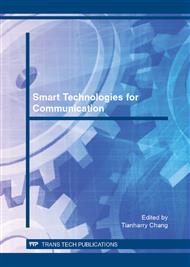[1]
S Choi, A Cichocki, H. M. Park, et al. Blind Source Separation and Independent Component Analysis: A Review [J]. Neural Information Processing, 2005, 6(1): 1-57.
Google Scholar
[2]
Chen Y Q, Tian Y F. Blind signal separation based on ppso-grads algorithm[J]. Journal of Electronic& Information Technology, 2007, 29(8): 1817-1820.
Google Scholar
[3]
A Belouchrani, M.G. Amin. Blind source separation based on time–frequency signal representations [J]. IEEE Trans. on Signal Processing , 1998, 46 (11): 2888–2897.
DOI: 10.1109/78.726803
Google Scholar
[4]
S Rickard, O Yilmaz. On the approximate W-disjoint orthogonality of speech[C]/ Proceedings of ICASSP, 2002: 529–532.
Google Scholar
[5]
O Yilmaz, S Rickard. Blind separation of speech mixtures via time–frequency masking [J]. IEEE Trans. on Signal Processing, 2004, 52 (7): 1830–1847.
DOI: 10.1109/tsp.2004.828896
Google Scholar
[6]
M Pedersen, T Lehn-Schioler, J Larsen. Blues from music: Blind underdetermined extraction of Sources from music[C]/ Proceedings of Independent Component Analysis and Blind Signal Separation, 2006: 392–399.
DOI: 10.1007/11679363_49
Google Scholar
[7]
N Linh-Trung, A Belouchrani, Abed-Meraimet K, et al. Separating more sources than sensors using time–frequency distributions[C]/Proceedings of the International Symposium on Signal Processing and its Applications, 2001: 583–586.
DOI: 10.1109/isspa.2001.950212
Google Scholar
[8]
A Aissa-El-Bey, N Linh-Trung, Abed-Meraimet K, et al. Underdetermined blind separation of nondisjoint sources in the time- frequency domain [J]. IEEE Trans. on Signal Processing, 2007, 55(3): 897–907.
DOI: 10.1109/tsp.2006.888877
Google Scholar
[9]
S. G. Kim, C. D. Yoo. Underdetermined Blind Source Separation Based on Subspace Representation [J]. IEEE Trans. on Signal Processing, 2009, 57(7): 2604-2614.
DOI: 10.1109/tsp.2009.2017570
Google Scholar
[10]
S Arberet, A Ozerov, R Gribonval, et al. Blind spectral-GMM estimation for underdetermined instantaneous audio source separation[C]/ Proceedings of 8th International Conference on Independent Component Analysis and Signal Separation, 2009: 751-758.
DOI: 10.1007/978-3-642-00599-2_94
Google Scholar
[11]
G. T. Pulido, C. A. C. Coello. A Constraint-Handling Mechanism for Particle Swarm Optimization[C]/ Proceedings of Evolutionary Computation, 2004, 2: 1396 – 1403.
DOI: 10.1109/cec.2004.1331060
Google Scholar
[12]
S Zhang, S.X. Gong. A modified PSO for low sidelobe concentric ring arrays synthesis with multiple constraints [J]. Journal of Electromagnetic Waves and Applications, 2009, 23: 1535-1544.
DOI: 10.1163/156939309789476239
Google Scholar


